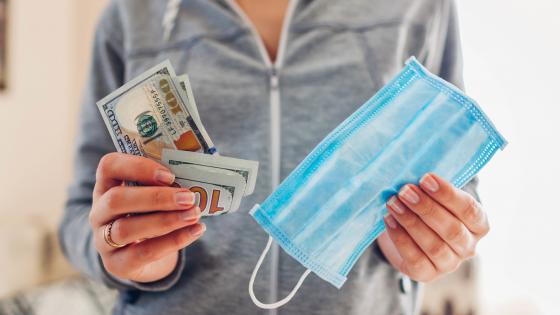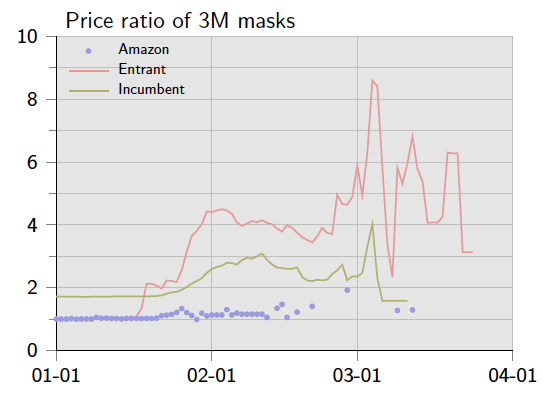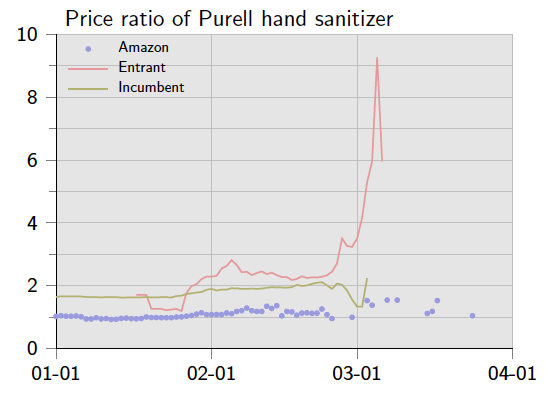In the wake of unexpected negative supply shocks — or positive demand shocks — prices tend to surge. Many economists, if not most, find such price hikes normal and in fact efficient: it is the law of supply and demand at work. By contrast, most of the world accuses sellers of price gouging and clamours for laws protecting buyers from unfair pricing. For example, in the aftermath of Hurricane Sandy, which struck the US in October 2012, New Jersey authorities filed civil suits accusing seven gas stations and one hotel of price gouging. Meanwhile, Libertarian TV personality John Stossel was inviting his readers to “hug a price gouger today”.
The tension between efficiency and fairness has existed for as long as economic relations have occurred. In our research, we investigate a third possibility which lies between the efficiency-only and the fairness-only extremes, namely the possibility that seller reputation may act as a moderator of ‘price gouging’ forces.
This is by no means a novel idea. For example, Akerlof (1980) argues that employers are unwilling to pay workers less than a fair wage — even if there is unemployment — for fear of a future employee boycott. Along similar lines, Kahneman et al. (1986) suggest that sellers may refrain from price gouging due to market reputation forces.
The goal of our research (Cabral and Xu 2020), is to develop this idea in the context of the recent COVID-19 pandemic and the multiple cases of price gouging that followed. We propose a test of Akerlof’s (1980) theory in the context of online sales (on Amazon) of a specific set of products, namely masks and hand sanitizers. Theory predicts that, during a time of excess demand, sellers with a reputation at stake are less like to hike their prices than sellers with no reputation to defend.
We construct a dataset of prices, measures of seller reputation, and indicators of excess demand. One natural measure of the distinction between sellers who have a lot to lose and sellers who don't have as much to lose is whether they are continuing or new sellers: All else equal, continuing sellers have a history (selling a particular product) and thus a reputation at stake.
Results
Figure 1 shows the ratio of daily prices during the 2020 pandemic and Amazon’s prices in 2019. We consider three groups of sellers: Amazon, the reference seller; continuing sellers, that already sold the product on Amazon before the pandemic broke out; and newly arriving sellers. The figure only plots price prices when a product is on sale. For example, we see that Amazon is stocked out most of the time after mid to late February. Continuing sellers stock out in early March. New sellers stop selling shortly after, mostly as a result of Amazon’s crack down on price gougers. In terms of price levels, the figures clearly suggest that newly arrived sellers are disproportionately more likely to price gouge and to do so to a greater extent.
Figure 1 Price ratio by type of seller
We then propose a formal test of Akerlof’s (1980) hypothesis. The results confirm the theory: Higher-reputation firms are less likely to take advantage of shortages of supply. The effect is statistically and economically significant. For example, during our sample period the 2020 price of 3M masks was 2.7 times higher than the average 2019 price. However, the difference (in price ratios between 2020 and 2019) between a new seller and a continuing seller is estimated to be about 1.6 at times of maximum scarcity. In other words, at times of maximum scarcity new sellers price-gouge at a level that is more than twice that of continuing sellers.
We consider various measures of seller reputation — that is, estimates of the seller's stakes — and various measures of scarcity. We always find economically and statistically significant moderating effects of seller reputation. That said, our analysis also suggests that these reputation effects are insufficient to completely limit the extent of price hikes.
Policy implications
In the US, federal and state legislation prohibits price gouging.1 However, terms such as “unreasonably excessive price increases” make it difficult to apply the statutes. In March, the attorney-generals of 34 states wrote to Amazon and other online marketplaces urging them to crack down on price gouging amidst the COVID-19 outbreak. On March 23, Amazon published a statement assuring that the platform operates “dynamic automated systems” that “locate and remove unfairly priced items”. Amazon’s statement notwithstanding, we observe significant price hikes on Amazon from mid-January until mid-March. One explanation is that the actual implementation of these mechanisms took place not long before the statement was published.
Our research does not address the bigger question of how to balance the fairness of anti-price gouging statutes against the efficiency of price increases as a signalling and incentive device.
However, our research suggests a specific rule to diminish the extent of price gouging, namely that new sellers be barred from setting higher prices than continuing sellers. The idea of this rule is to leverage the market-based reputation mechanism (as it applies to continuing sellers) so as to prevent the unfair effect of opportunistic entry and price gouging.
While we do not have a structural model that would allow for a meaningful counterfactual, the data suggests that such a rule would diminish the extent of price hikes considerably. The rule has the advantage of being transparent and easy to apply. Finally, it is a market-based rule, as it puts the consumer back in the driver’s seat, judging — through the seller’s reputation mechanism — what is a fair price increase and what is not.
References
Akerlof, G A (1980), “A Theory of Social Custom, of which Unemployment may be One Consequence,” The Quarterly Journal of Economics 94(4):749–775.
Cabral, L and L Xu (2020), “Seller Reputation and Price Gouging: Evidence from the COVID-19 Pandemic”, NYU and Bank of Canada.
Fiorini, M, B Hoekman and A Yildirim (2020), “COVID-19: Expanding Access to Essential Supplies in a Value Chain World”, Chapter 4 of Baldwin and Evenett (ed), COVID-19 and Trade Policy: Why Turning Inward Won’t Work.
Kahneman, D, J L Knetsch and R Thaler (1986), “Fairness as a Constraint on Profit Seeking: Entitlements in the Market”, American Economic Review 76(4):728–741.
Endnotes
1 See Fiorini et al. (2020) for an analysis of the pitfalls of public policy in the context of price gouging.





